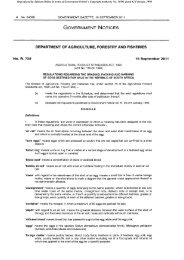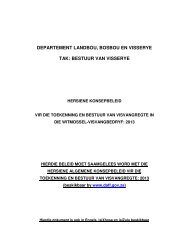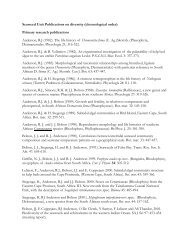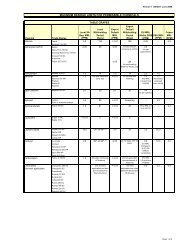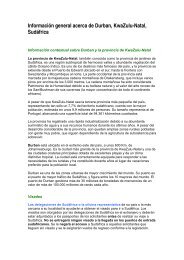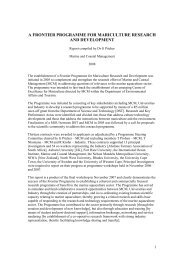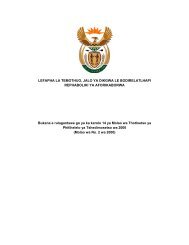Create successful ePaper yourself
Turn your PDF publications into a flip-book with our unique Google optimized e-Paper software.
cloud of ink to confuse the predator. One deep-sea species<br />
ejects a cloud of luminescent ink which is more effective at<br />
startling predators in the dark depths of the ocean.<br />
Squids, cuttlefish and octopuses are able to change their colour<br />
very rapidly by expanding or contracting their chro m a t o p h o re s<br />
– cells in their skin that contain pigment. Colour change is<br />
particularly important in the courtship of squids. When they are<br />
ready to mate, male squid will display dark stripes of colour on<br />
their dorsal surface. If they approach another male, he will bre a k<br />
into similarly vivid patterning. But receptive females will re m a i n<br />
pale to signify that they are open to the male’s approaches.<br />
Sperm transfer is a complex procedure. Male reproductive<br />
organs package the sperm into spermotophores and these<br />
are deposited inside the female’s mantle cavity by the male<br />
who uses a specially adapted arm. In some species the<br />
spermatophores then absorb water and burst open, releasing<br />
the sperm. In others, the spermatophores are triggered to<br />
open as the arm is withdrawn and pulls on a filament.<br />
The female releases her eggs and once they are fertilized,<br />
surrounds them with a protective mucous sheath. Octopuses<br />
lay large clusters of eggs and the female octopus tends them<br />
until they hatch. Cuttlefish eggs are each enclosed in a black<br />
capsule and attached to a seaweed frond by a loop. The<br />
cephalopod embryo develops completely within the egg case<br />
and hatches as a fully formed juvenile.<br />
A growing market for cephalopods<br />
World cephalopod catches, and consumer interest in<br />
cephalopod products, have both increased markedly<br />
since the 1980s. Japan is by far the largest market<br />
and in 1996 Japan consumed almost one third<br />
of the world’s supply of cephalopods, or<br />
900 000 tons. Other markets for<br />
cephalopods exist in<br />
other parts of Asia<br />
and in European<br />
countries with a<br />
Mediterranean coastline.<br />
South Africa exports the<br />
bulk of its squid catch to Italy<br />
and other European countries.<br />
South Africa’s squid jig-fishery is based in the Eastern Cape<br />
Province, mainly between Plettenberg Bay and Port Alfred. It<br />
is one of the country’s newer commercial fisheries, having<br />
started in the early 1980s, when squid became sought after as<br />
the restaurant delicacy, calamari. The fishery is based on the<br />
chokka or long-finned squid, Loligo vulgaris reynaudii, which is<br />
caught by handline, using a lure called a jig, when the animals<br />
move inshore and form large spawning aggregations in shallow<br />
bays. Fishing is conducted during the day as well as at night,<br />
using very bright lights to attract squid to the fishing boats.<br />
Catches fluctuate between 2 000 t and 10 000 t per annum.<br />
Control measures include a permit system that limits the<br />
number of participants in the fishery, a four-week closed<br />
season and a closed area in the Tsitsikamma National Park<br />
which is an important spawning ground for squid.<br />
For many years common and giant octopuses have been<br />
caught in the nets of deep sea trawlers. Increasing demand<br />
for octopus products from European markets has prompted<br />
South African fisheries authorities to consider issuing experi-<br />
mental permits to test the biological and economic viability of a<br />
directed octopus fishery. The permits may allow ten operators<br />
to catch and market 20 t of octopus each. It is likely that<br />
fishers will target the common octopus, a near-shore species<br />
which can weigh up to six kg.<br />
Author: Claire Attwood September 2000<br />
Common octopus<br />
FURTHER INFORMATION: • Branch, G. and Branch, M. 1981. The Living Shores of Southern Africa . Struik Publishers, Cape Town.<br />
• Payne, A.I.L. and Crawford, R.J. (Eds) 1989. Oceans of Life off Southern Africa. Vlaeberg Publishers, Cape Town.<br />
RELATED FACTSHEETS: • Octopus • Squid Fishery • Sea Shells • Seafood Delicacies<br />
For more information, please contact: The Coastal Management Office, Marine and Coastal Management, Department of Environmental Affairs and Tourism, Private Bag X2,<br />
Roggebaai 8012, Cape Town, South Africa. Tel: +27 (0)21 402-3208 Fax: +27 (0)21 418-2582 e-mail: czm@mcm.wcape.gov.za Website: http://sacoast.wcape.gov. z a







